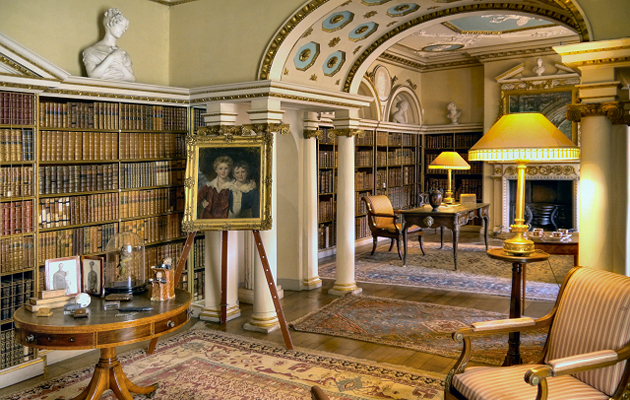The country house library is back in fashion and collecting books is in vogue. A well-stocked and handsome library remains a mark of a gentleman's residence.
The Country House library, I am surprised to report, is a room with a future. For the surprise is this: among rich owners in the countryside, the country house library is coming back.
In the past 20 years one of the finest country house libraries of any era has been built at Wormsley Park, Oxfordshire by Sir Paul Getty. “Not just a country house library, it is an objet d’art,” enthuses an admiring bookseller, Stephen Bainbridge of Ludlow, “rich in fine bindings and rich in every subject.”
COUNTRY HOUSE LIBRARY. NEW AND EXCITING
Important new country house libraries have been formed at Tusmore Park near Bicester, newly built in the Georgian style by Wafic Said, and at Langton House, Alresford by Robert Lloyd George. Three more in Hampshire, Wiltshire and near Bath are attested by Mayfair book dealers Ed Maggs in Berkeley Square and Nicky Dunne at the Duke of Devonshire’s bookshop, Heywood Hill in Curzon Street.
“The revival of UK book collecting owes everything to Mrs Thatcher reducing top rate tax some 30 years ago – 98% to 40% on investment income, 83% to 40% on earned income,” explains Christopher Sokol, proprietor of Sokol Books in London’s Fulham Road. “That allowed money for what was previously a luxury. In the era of Marxist taxation British buyers were just too poor. All the significant book customers were abroad. Now, numerous new UK collections have begun.”
And not just in country houses. Plenty of new libraries grow in prime central London homes, say dealers – those of Sir John Ritblat and Lord King among the better known. You can’t move in Heywood Hill’s Mayfair shop in 2014 for five Himalayan mountains of books in boxes on Arabia, the World Wars, country sports, partridges and modern art, all destined for addresses in the capital.
That little list reveals that new libraries are more often single-theme collections in the 21st century than Grand Tourish surveys of mankind.
“The proper way to build a country house library is round a single idea,” according to Bainbridge. It’s “proper” not least because single-theme collecting is still possible and makes market sense. “If you are ready to buy over decades, you can still create a supreme library like this.”
That little of this is known is because book dealers keep their secrets and are notoriously as gloomy as farmers. As they tell it, the sun shines but rain is certain. So that hedonist with a wide smile on his visage, Ed Maggs, assures me that the book trade is in “general malaise”. Dealer Ed Bainton in Bath sees “green shoots but no bed of summer flowers”. Bainbridge calls for “young blood, new collectors,” adding that, “Today’s library-builders are mostly squires, eccentrics and minor aristos in the City of London who feel themselves part of a bygone era.”

Pick the right books for your shelves.
LIBRARIES – RAIN OR SHINE?
Hunt it out, therefore, and bad news is at every hand: interior designers do not like books; the internet kills reading; country-house library owners add missing volumes but not new areas to their collections; the book market is mature; not enough new starts…
Do dealers really believe this? The truth is that in books, as in art, the 2% masterpiece market is in vigorous action while the 98% market is calm – not dead.
So, when the sun is out, “the need to surround oneself with books remains an immensely strong instinct for some people,” proclaims Maggs cheerfully.”Not just collecting, the idea of a library is reviving,” says Dunne. “It’s happening everywhere – in country houses, in fishing and shooting lodges, in any house.” “A private library is a distinction that more and more people want to take on,” Bainton claims.
The Country House library has regained a firm footing in the architectural world. But often they are dispersed when times become tough. Downton Abbey, we all now know, is Highclere Castle, Hampshire; what most don’t know is that this suave and imposing castle built by Sir Charles Barry in 1842 is in crisis, that only its ground and first floors are habitable and 50 rooms are not. The eighth Earl of Carnarvon, its owner, needs £1.8 million urgently for in-house repairs and £10 million more for the estate. “Worrying how to keep it going gives me sleepless nights,” he declares.
What Lord Carnarvon has not done – for which we must salute him – is what many others do when the wolf howls at the door: sell the art and the books.
Downton, dramatising the Carnarvon perils, has not yet rushed to Christie’s with portraits by Lawrence and Reynolds, as happened in 1924-25, nor flogged supreme Egyptian works of art to the Metropolitan Museum in New York. Nor has Lady Mary sent the lovely Victorian library to auction. This is, as viewers can see, no threadbare bookish retreat but the warmest and prettiest room in the house.





